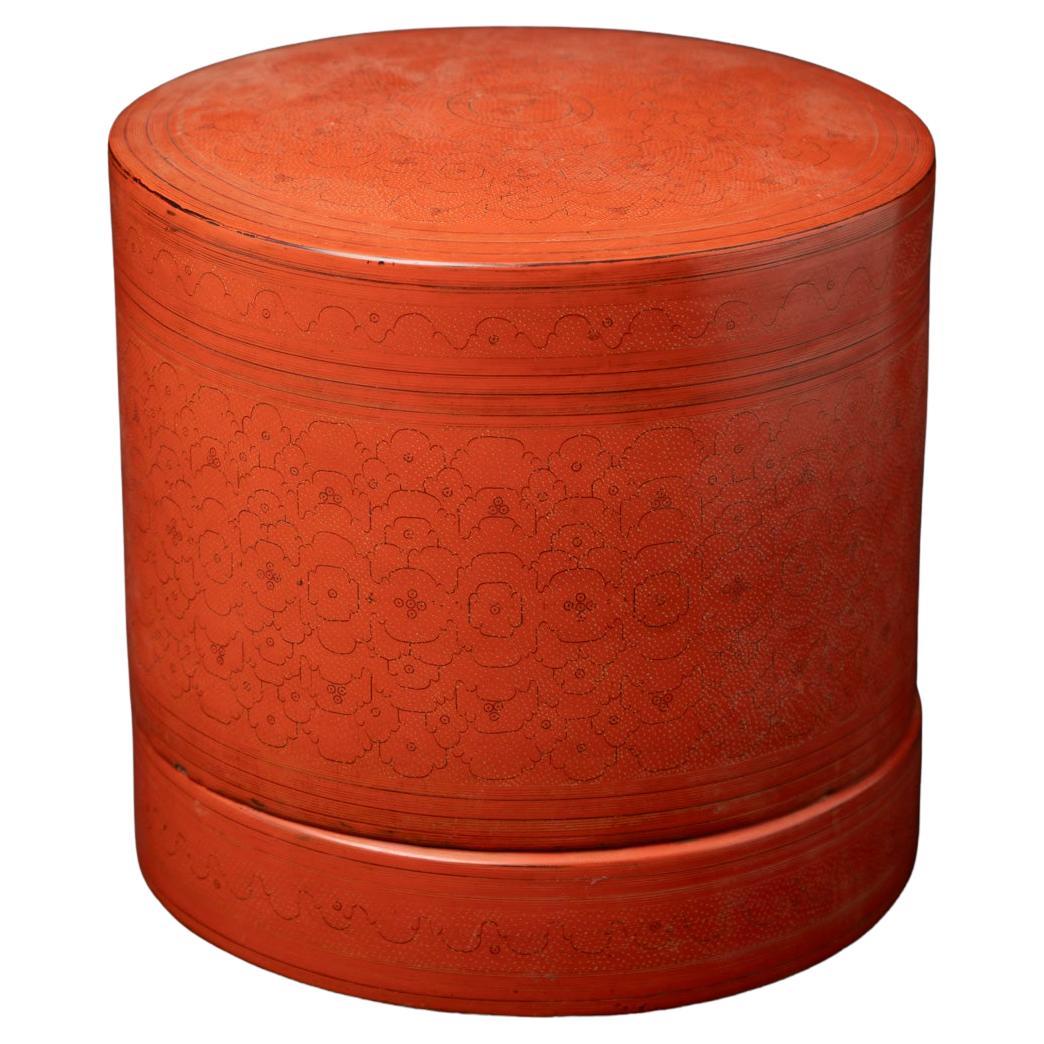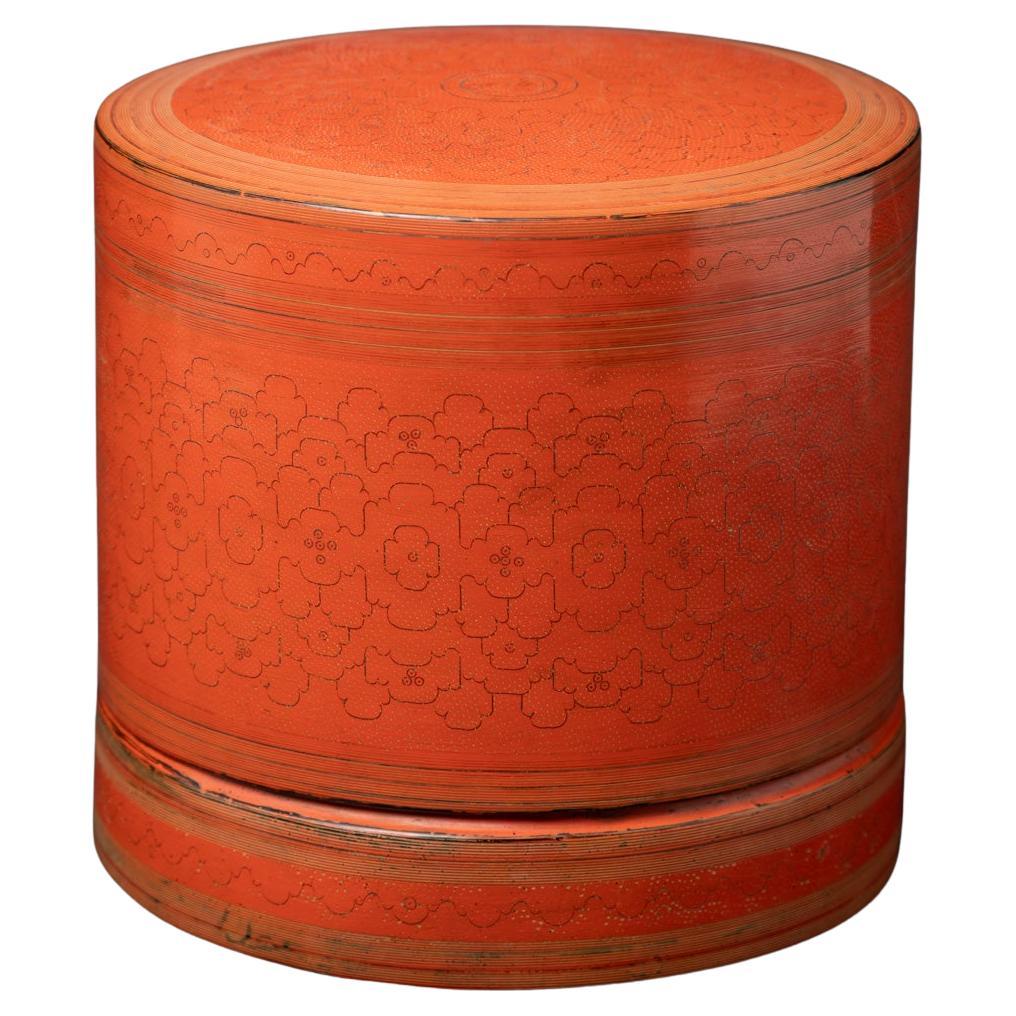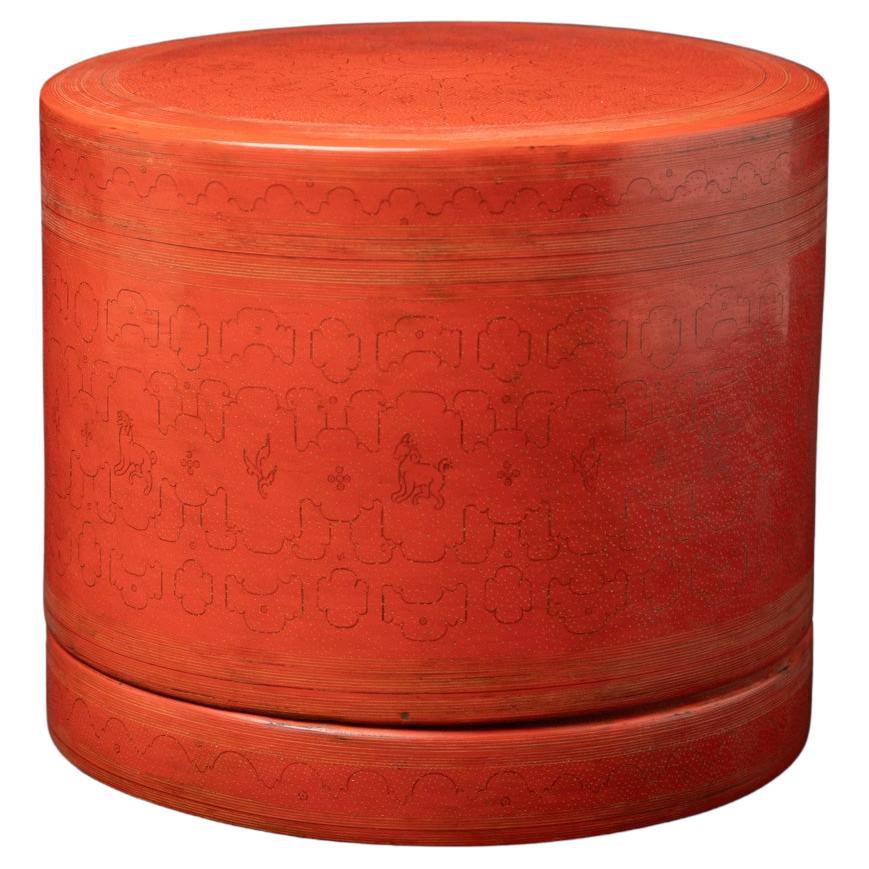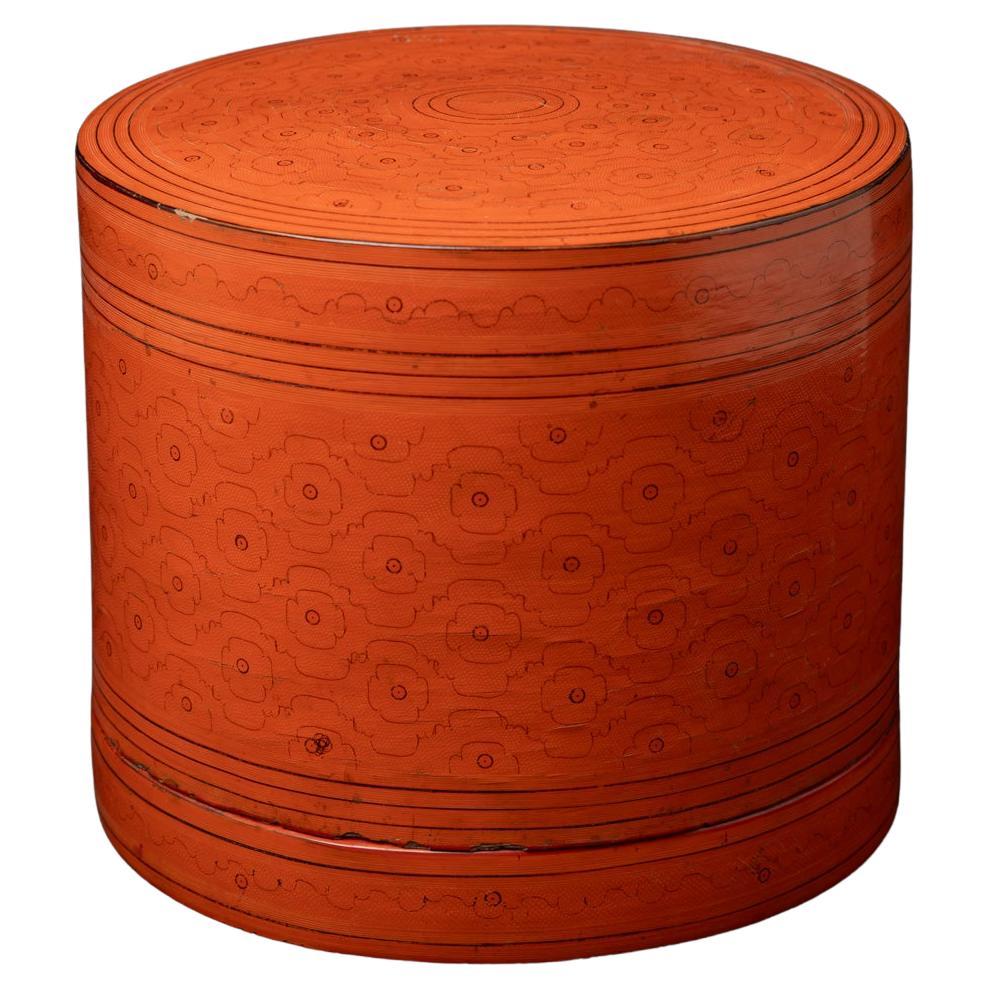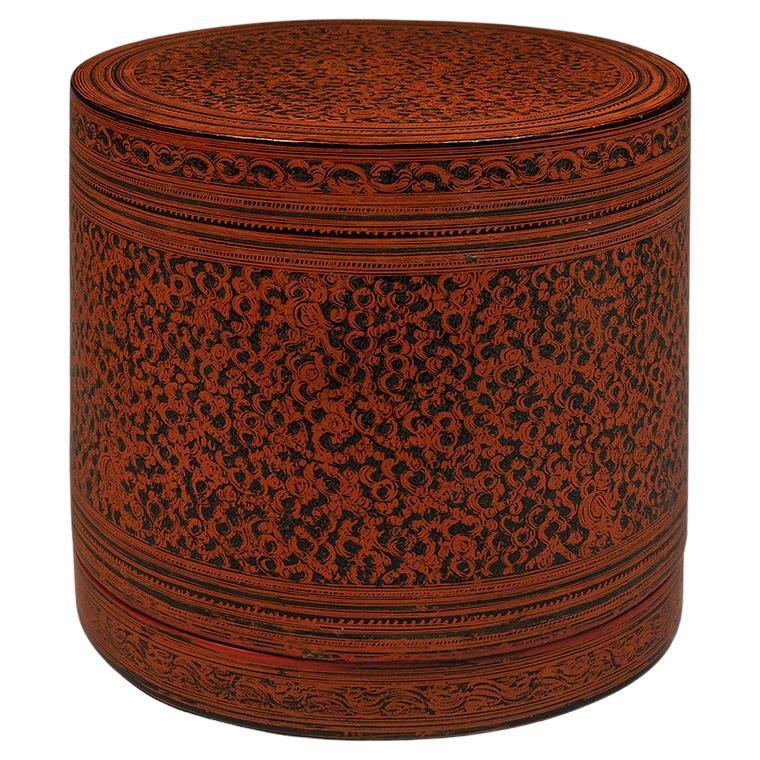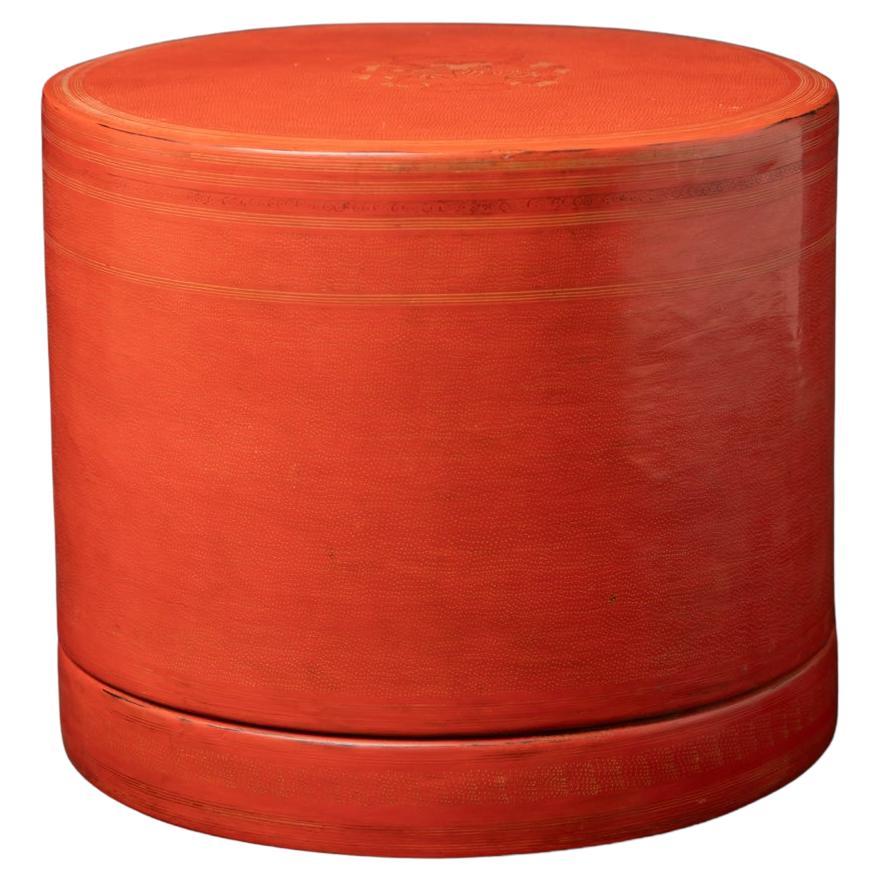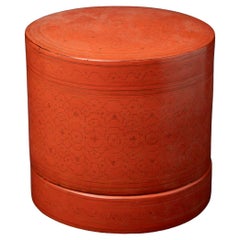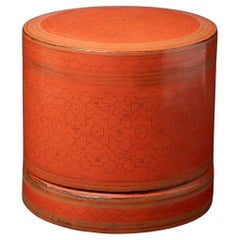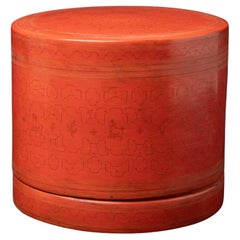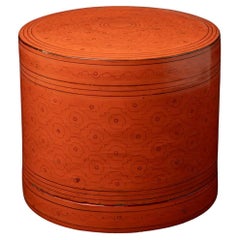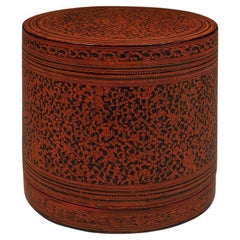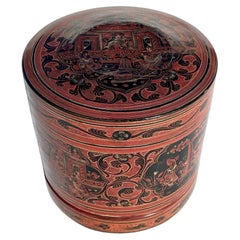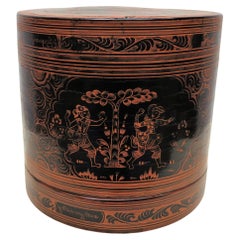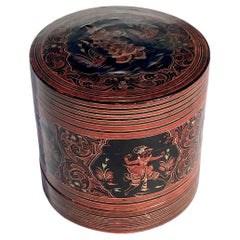Items Similar to Special antique Burmese lacquerware betelnut box from Burma
Video Loading
Want more images or videos?
Request additional images or videos from the seller
1 of 11
Special antique Burmese lacquerware betelnut box from Burma
$882.12
£660.29
€748
CA$1,214.05
A$1,353.19
CHF 709.97
MX$16,524.62
NOK 8,989.78
SEK 8,496.71
DKK 5,694.30
About the Item
This special antique Burmese lacquerware betelnut box is a remarkable example of 19th-century craftsmanship from Burma (modern-day Myanmar), showcasing the rich cultural heritage and artistic refinement of traditional Burmese lacquer art. Crafted with great skill, the box stands 19.5 cm high with a 21.5 cm diameter and weighs 1.09 kilograms, making it a substantial and visually impressive piece. Made entirely of lacquerware, it features beautifully detailed decorations that reflect the intricate patterns and symbolic motifs typical of Burmese design.
Traditionally used to store betelnuts—an essential part of Burmese social and ceremonial life—this box not only served a practical purpose but also stood as a status symbol and work of art. With its age, authenticity, and exquisite craftsmanship, this antique Burmese betelnut box is a collector’s treasure, ideal for those who appreciate Southeast Asian antiques, cultural history, or finely detailed decorative pieces with a story to tell.
Special antique Burmese lacquerware betelnut box
Material : lacquerware
19,5 cm high
21,5 cm diameter
19th century
With beautiful decorations !
Weight: 1,09 kgs
Originating from Burma (Myanmar)
- Dimensions:Height: 7.68 in (19.5 cm)Width: 8.47 in (21.5 cm)Depth: 8.47 in (21.5 cm)
- Materials and Techniques:
- Place of Origin:
- Period:
- Date of Manufacture:19th century
- Condition:Wear consistent with age and use.
- Seller Location:DEVENTER, NL
- Reference Number:Seller: 3881-311stDibs: LU7845245212792
About the Seller
5.0
Vetted Professional Seller
Every seller passes strict standards for authenticity and reliability
Established in 1997
1stDibs seller since 2022
57 sales on 1stDibs
Typical response time: 6 hours
- ShippingRetrieving quote...Shipping from: DEVENTER, Netherlands
- Return Policy
Authenticity Guarantee
In the unlikely event there’s an issue with an item’s authenticity, contact us within 1 year for a full refund. DetailsMoney-Back Guarantee
If your item is not as described, is damaged in transit, or does not arrive, contact us within 7 days for a full refund. Details24-Hour Cancellation
You have a 24-hour grace period in which to reconsider your purchase, with no questions asked.Vetted Professional Sellers
Our world-class sellers must adhere to strict standards for service and quality, maintaining the integrity of our listings.Price-Match Guarantee
If you find that a seller listed the same item for a lower price elsewhere, we’ll match it.Trusted Global Delivery
Our best-in-class carrier network provides specialized shipping options worldwide, including custom delivery.More From This Seller
View AllOld Burmese lacquerware betelnut box from Burma
Located in DEVENTER, NL
This old Burmese lacquerware betelnut box is a finely crafted piece from the early 20th century, originating from Burma (modern-day Myanmar), and ref...
Category
Early 20th Century Burmese Sculptures and Carvings
Materials
Lacquer
Old Burmese lacquerware betelnut box from Burma
Located in DEVENTER, NL
This old Burmese lacquerware betelnut box is a charming and authentic piece of early 20th-century craftsmanship from Burma (now Myanmar). Measuring 17.5 cm in height with an 18.6 cm diameter and weighing 818 grams, this delicately made box reflects the traditional techniques and cultural heritage of Burmese lacquerware artisans. Crafted from finely layered lacquer over a bamboo or wood base, it would have originally been used to store betelnuts—a common and culturally significant offering in Burmese social and religious practices.
The surface likely features classic Burmese motifs or decorative patterns, characteristic of the period and region. This piece is not only a functional container but also a beautiful example of Southeast Asian folk art. Perfect for collectors of ethnic antiques...
Category
Early 20th Century Burmese Sculptures and Carvings
Materials
Lacquer
Old Burmese lacquerware betelnut box from Burma
Located in DEVENTER, NL
This old Burmese lacquerware betelnut box is a beautifully preserved example of early 20th-century craftsmanship from Burma (now Myanmar), showcasing the timeless elegance of traditi...
Category
Early 20th Century Burmese Sculptures and Carvings
Materials
Lacquer
Old Burmese lacquerware betelnut box from Burma
Located in DEVENTER, NL
This old Burmese lacquerware betelnut box is a beautifully preserved artifact from the early 20th century, showcasing the refined craftsmanship and...
Category
Early 20th Century Burmese Sculptures and Carvings
Materials
Lacquer
Old Burmese lacquerware betelnut box from Burma
Located in DEVENTER, NL
This old Burmese lacquerware betelnut box is a fine example of early 20th-century craftsmanship from Burma (modern-day Myanmar), reflecting the region’s deep-rooted lacquerware tradi...
Category
Early 20th Century Burmese Sculptures and Carvings
Materials
Lacquer
Early 20th century Old Burmese betelnut box from Burma
Located in DEVENTER, NL
This old Burmese betelnut box is a classic example of early 20th-century lacquerware artistry from Burma (modern-day Myanmar). Expertly handcrafted using traditional techniques, this...
Category
Early 20th Century Burmese Sculptures and Carvings
Materials
Lacquer
You May Also Like
Late 19th Century Lacquer and Bamboo Betel Box, Burma
Located in Point Richmond, CA
Betel Box, Kun It
Burma
Late 19th/early 20th century
Bamboo, lacquer
H: 7.5 in x D: 8.5 in :: 19 cm x 21.5 cm
Intricately painted motifs (including chili seed pattern, Nga Y...
Category
Antique Late 19th Century Burmese Tribal Lacquer
Materials
Bamboo, Lacquer
Vintage Burmese Betel Box “Kun-It”
Located in Point Richmond, CA
Vintage Burmese Betel Box “Kun-It”, a cylindrical woven container with a deep lid and shallow interior tray, all covered in layers of red black and...
Category
Mid-20th Century Burmese Folk Art Lacquer
Materials
Bamboo, Lacquer
Burmese Lacquerware Betel Box
Located in New York, NY
Burmese antique lacquerware betel box. Individual Betel Box authentic Burmese Folk Art know as Kun- It, Mandalay Period. A lacquered cylindrical body of woven turned Bamboo decorated by incised lacquer overall with Chu-pan variant motif and traditional Folk Art characters. This Betel Box has four bowls that make up the entire box. This is a complete Burmese Lacquerware Betel Box.
Each bowl has a purpose. The top and base work as large containers and two shallow dishes work as small bowls. The workmanship is very unique having exquisite height details to the bottom of the base container and the two shallow bowls showcasing a complex design to the weaving. Antique Burmese Lacquerware is highly collectible, having books written on this Folk Art with museums having collections and exhibits of same. A very nice antique Burmese Betel Box...
Category
Early 20th Century Burmese Other Decorative Boxes
Materials
Lacquer
Vintage Burmese Betel Box “Kun-It”
Located in Point Richmond, CA
Vintage Burmese Betel Box “Kun-It”, a cylindrical woven container with a deep lid and shallow interior tray, all covered in layers of red black and...
Category
Mid-20th Century Burmese Folk Art Lacquer
Materials
Bamboo, Lacquer
Highly Decorative Antique Burmese Lacquered Betel Box / Kun-It, Circa 1900
Located in Ottawa, Ontario
The vermillion lacquered cylindrical body decorated overall with repeating bands of curvilinear geometric motifs, the cover lifting to reveal both of its original trays intended to h...
Category
Early 20th Century Burmese Lacquer
Materials
Lacquer, Bamboo
Large Incised Lacquer Hsun-ok Offering Box With Interior Tray, Bagan, 20th C.
Located in Point Richmond, CA
Exceptional Large Incised Lacquer Hsun-ok Offering Box With Interior Tray, Bagan, 20th Century.
The large round bowl form is for holding cooked rice and the interior tray is for ho...
Category
20th Century Burmese Folk Art Sculptures and Carvings
Materials
Wood, Lacquer
More Ways To Browse
Burmese Burma
Burma Box
Burma Lacquerware
Burmese Lacquerware
Lacquer Box Burma
Chinese Soapstone
Chinese Stone Statue
Soapstone Chinese Furniture
Asian Bird Box
Japanese Koi
Asian Root Furniture
Asian Carved Wood Wall Art
Japanese Netsuke
Cast Iron Japanese
Japanes Cast Iron
Japanese Wood Masks
Large Jade Carving
Wood Mask Japan
